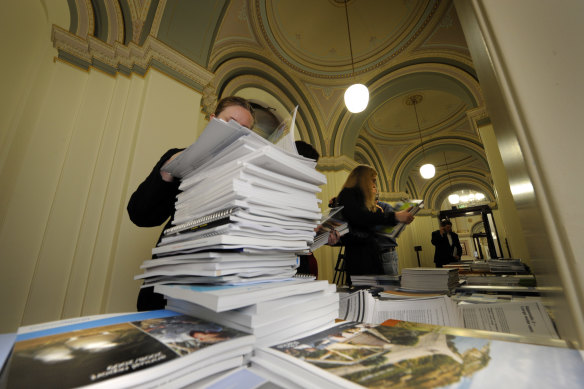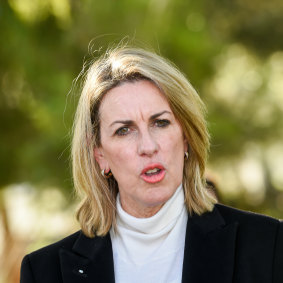Hospitals, homes and hoons: Everything you need to know about ‘Dump Day’ 2024
More than a quarter of Victoria’s emergency patients are not being treated within the recommended time frames, as the Allan government also falls short on a raft of other performance benchmarks.
The failings are detailed in the Health Department’s annual report, tabled in state parliament on Thursday – along with more than 170 other documents.

Dump Day has a long history. This picture was taken in 2009, when John Brumby was Labor premier. A mountain of reports were rush-released then, too.Credit: Penny Stephens
The annual event known as “Dump Day” involves the state government publishing a mountain of reports and documents over a few hours – an effort to make sure journalists have as little time as possible to scrutinise them.
The health report showed that while all category 1 patients – those who require resuscitation – were treated immediately, just 71.1 per cent of total patients presenting to emergency departments were seen on time in the 12 months to June 30, 2024.
The government will need to slash waiting times for tens of thousands of emergency department arrivals if it is to reach its target of 80 per cent punctuality by the end of this financial year.
Victoria uses a five-tiered triage system for emergency departments. Category 2 patients require treatment within 10 minutes, while category 5 requires treatment within two hours.
Ambulance ramping continues to be an issue in Victoria, with just 65 per cent of patients handed over to hospitals within 40 minutes.
In September, The Age reported on a 69-year-old eastern suburbs man who was found dead four hours after a neighbour first heard him calling for help and phoned triple zero.
Fewer than half of mental health patients were transferred from an emergency department to a mental health bed within eight hours last financial year, the report shows.
And just 45 per cent of families and carers reported an “excellent” or “very good” experience with the mental health system. In both cases, the target was 80 per cent.

Opposition health spokeswoman Georgie CrozierCredit: Justin McManus
The department’s latest annual report also confirmed there were 209,907 planned operations completed in the 12 months to June 30, 2024. This was a record, but fewer than the 240,000 the government had hoped to hit before The Age revealed it had quietly scrapped this benchmark during the year.
Opposition health spokeswoman Georgie Crozier said this year’s Dump Day showed Labor could not be trusted to fix the state’s health crisis.
“The Allan Labor government has run the public hospital system into the ground,” she said. “Victorians cannot get the care they need when they need it most.”
A state government spokesperson said Labor had taken pressure off emergency departments by investing in 29 urgent care clinics and expanding its community pharmacy scheme.
“Health systems globally are under significant pressure following the one-in-100-year pandemic,” the spokesperson said. “It’s why we are investing a record more than $20 billion into our health services this year alone. Only Labor invests in our health system.”
Here’s what else we learnt from Dump Day 2024.
Housing
The average waiting time for someone considered a priority for public housing has increased to 19.8 months, up from 18.1 months the year before and 15.2 months two years ago. The target is 10 months.
The Department of Families, Fairness and Housing said the waiting time reflected strong demand for social housing.
The department planned to pay the bond for 10,000 low-income Victorians last financial year to help them in the private rental market, but paid for only 6932 of them because of high competition in the private market.
The government’s Big Housing Build is also behind schedule, with 89,501 social homes in the state instead of the 91,248 the government hoped to have by June 30 this year.
Opposition housing spokesman Richard Riordan said the figures were a “disastrous scorecard” and accused the government of adding to the housing crisis.
He said only 2688 extra homes had been added as social and community housing since 2018, an increase of 3.1 per cent, which was well below then-premier Daniel Andrews’ pledge in 2020 to boost this supply by 10 per cent within four years.
Transport
Delays and budget blowouts have become more widespread in Victoria’s Big Build transport infrastructure program.
Only 62 per cent of projects were completed within their agreed scope, time frame and budget in financial year 2024 – down from 73 per cent in 2023, 84 per cent in 2022 and 76 per cent in 2021.
Transport infrastructure spending was more than three times higher than targeted – $778.7 million for the year, compared with $237 million – after the release of contingency funding for the Level Crossing Removal Program, the Suburban Rail Loop and the Metro Tunnel.
Traffic
The number of vehicles impounded or surrendered because of high-risk driving behaviour and other traffic offences was lower than expected last financial year because of a decrease in enforcement activities “as a result of a temporary reallocation of resources to emergency management events and public order response”.
Population growth has contributed to a higher-than-hoped number of people injured in vehicle collisions, as did a “significant growth in the use of alternative transport options such as e-bikes and e-scooters”.
Building watchdog
In June last year, parliament passed legislation to establish a building monitor to ensure the troubled Victorian Building Authority was working for consumers. But the government still hasn’t appointed a monitor, the authority’s annual report shows.
The VBA received 1773 building complaints and 1809 plumbing complaints last financial year, and finalised 14 criminal prosecutions through the courts. Another 39 prosecutions are continuing.
The number of building permits issued for new builds fell by 7 per cent year-on-year to 57,876 across the state, but overall cost of works increased by 4 per cent to $49.2 billion.
Firefighters
The Department of Justice and Community Safety was unable to report on the results of some of Fire Rescue Victoria’s (FRV) performance measures because of a cyberattack almost two years ago. FRV couldn’t say whether it met its emergency response time benchmark for road accident rescues as a result. Nor could the department say what percentage of structural fires were confined to the room in which the fire broke out.
Country Fire Australia also failed to meet its emergency response time benchmark for structural fires by 10 percentage points.
Environment
Victoria’s Port of Hastings is still trying to build an offshore wind hub in the region despite the project being rejected by the federal environmental approvals process.
In January, federal Environment Minister Tana Plibersek surprised the Allan government by rejecting an approval to build the renewable energy terminal, which is where parts of offshore wind turbines could be assembled before being taken out to sea.
It was rejected because of its impact on areas protected by the Ramsar Convention, an agreement signed by more than 170 countries that pledges to promote the conservation of wetlands.
In its annual report, the Port of Hastings Corporation said it was still working on an environmental effects statement for the terminal following the rejection.
Start the day with a summary of the day’s most important and interesting stories, analysis and insights. Sign up for our Morning Edition newsletter.